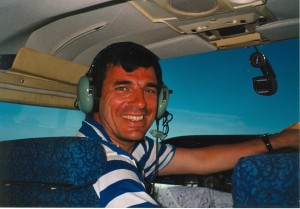Glad you asked!
Those of us who are pilots are always saying that flying is basically “hours and hours of shear boredom, interspersed with moments of shear terror.” I recently saw the youtube above of a midair crash between two planes from which everyone survived. They all had parachutes! There was a bit of a scramble to get out of the planes, but they all made it. Sadly there was once another situation some years back where ten jumpers with chutes were in the back of the plane ready to jump. They had moved the center of gravity so far aft that the pilot lost control. The sad part was that centrifugal force of the spinning plane was such that no one could get out. So the lesson is – boredom is better.
Thankfully no one dies from IT crashes – at least it is very rare. As in aviation, so in IT. Boredom is better. So why do we reward the intrepid system admin who was up all night fixing the crashed system? I would tell my operations people that I appreciate their heroics, but I would appreciate it more if they would find a way to not need the heroics.
As Protos has become more involved in high performance computing, I have kept a list of the issues our customers and prospects have with their computer systems. It is always the same ten things or some variation.
Here is the list – in the form of questions:
- “Where is the IT guy when you need him?”
- “Why did it fail?”
- “What do you mean we never tested the backup?”
- “The internet was cut? No way!”
- “We were hacked?”
- “We have to spend more this year, too?”
- “Not enough storage?”
- “I thought we had virus protection?”
- “Are we compliant with the regulations?”
- “Why does a version change take so long?”

From the day a business begins, so does the mad dash to make the system keep up with the business. It is something like a patchwork quilt, where each step seemed to be the right thing at the time, but the quilt is getting a little ragged around the edges. What is the big picture and where are we going? I challenge CIOs to decide where they want (or need) to be in 3 years and then put together a plan to get there. If at the end of each week they have not made progress, then they will not make it.
In a nutshell, as far as the infrastructure goes, you will be virtualized. You will be in a real data center, run by professionals. You will be using web-enabled software. Everyone will have secure access to all the files they need from any device and from anywhere. The public and private cloud will be available as appropriate and nothing will ever fail. That’s the three year plan.
Now the good news is that you do not have to wait three years for all this. Just give us a call. We have it all, available by the desktop or by the rack.
ShareDEC

About the Author:
While I was at Stanford, I got to know Dr. William Schockley, the inventor of the transistor. While at Bell Labs I produced the first computer generated animation, I worked on the first packet switch and the first picture-phone. I worked with the inventors of Unix and C. I produced multiple compilers, operating systems and microcode. I worked with the Snobal language - the precursor to Perl and Ramis the precursor to SQL. The building I worked in was home for 5000 of the smartest people in the industry. We had Phd's cutting the grass. (just kidding). I never had it so good again. Today that building is empty and for sale. After the Bell System, I spent 25 years in the satellite industry. I led development teams in the VSAT industry. I started and grew early stage companies in this industry. Recently I have been involved in cloud computing startups focused on infrastructure and virtual desktops.